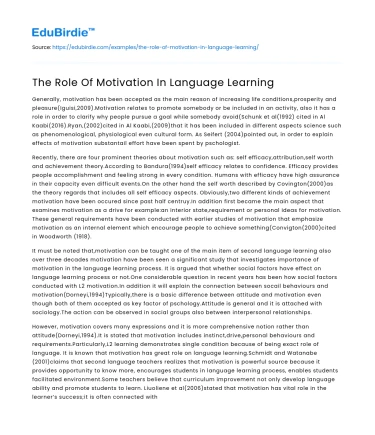Introduction
In the field of applied linguistics, motivation is widely recognized as a pivotal factor influencing the efficacy of language learning. As language learners navigate through the complexities of acquiring a new language, motivation acts as a catalyst that drives them towards achieving proficiency. The multifaceted nature of motivation encompasses various elements, including intrinsic and extrinsic factors, which together shape a learner's commitment and persistence. This essay seeks to explore the dynamic role of motivation in language learning by examining its different dimensions, discussing real-life cases, and considering counter-arguments to provide a comprehensive understanding of its impact. Through an analytical lens, we will delve into how motivation not only influences language acquisition but also interacts with other cognitive and affective factors, leading to varied learning outcomes.
Intrinsic and Extrinsic Motivation
Intrinsic motivation refers to engaging in an activity for its inherent satisfaction rather than for some separable consequence. In language learning, intrinsic motivation is manifested when learners are driven by their interest or enjoyment of the language itself. This form of motivation has been associated with higher levels of engagement and perseverance. Deci and Ryan's Self-Determination Theory posits that intrinsic motivation is fostered when learners experience autonomy, competence, and relatedness. For example, a learner who studies Spanish out of a genuine interest in Hispanic culture is likely to achieve greater linguistic proficiency compared to one who is motivated solely by external rewards. Research by Ushioda (2008) underscores that intrinsic motivation not only enhances language retention but also fosters a deeper connection with the language, facilitating a more holistic learning experience.
Save your time!
We can take care of your essay
- Proper editing and formatting
- Free revision, title page, and bibliography
- Flexible prices and money-back guarantee
Conversely, extrinsic motivation involves performing an activity to achieve an outcome separate from the activity itself, such as obtaining a job or passing an exam. While extrinsic motivators can prompt learners to initiate language study, they may not sustain long-term engagement. However, when external incentives are aligned with personal goals, they can enhance motivation. Dörnyei (2009) argues that the integration of extrinsic motives with intrinsic goals can create a balanced motivational framework, optimizing language learning outcomes. Nonetheless, the reliance on extrinsic motivation alone can lead to superficial learning, where students focus on rote memorization rather than developing communicative competence.
Case Studies and Empirical Evidence
The role of motivation in language learning is well-documented in empirical studies. A notable example is the Gardner and Lambert (1972) study, which explored the integrative and instrumental orientations of motivation. Integrative motivation, where learners have a desire to integrate and identify with the culture of the language community, was found to be a strong predictor of language success. This is evident in cases where immigrants rapidly acquire the host country's language, driven by the need to assimilate and form social connections. Conversely, instrumental motivation, focused on tangible benefits such as career advancement, showed varying levels of effectiveness depending on the context and learner's goals.
Recent studies continue to affirm the significance of motivation. A meta-analysis by Alrabai (2016) concluded that motivated learners exhibit higher achievement levels, increased usage of language learning strategies, and greater persistence in the face of challenges. Real-world examples, such as the widespread adoption of language apps like Duolingo, illustrate how gamified elements can enhance motivation by providing immediate feedback and rewards, thus sustaining learner engagement. However, the success of such platforms also highlights the importance of personalization in fostering motivation, as learners are more inclined to persist when learning experiences are tailored to their interests and goals.
Counter-Arguments and Challenges
Despite its acknowledged importance, some argue that motivation alone is insufficient for successful language acquisition. Critics contend that cognitive factors such as aptitude, working memory, and learning strategies play equally crucial roles. Skehan (1989), for instance, emphasizes that while motivation can drive effort, cognitive abilities ultimately determine a learner's capacity to process and retain language input. Furthermore, the sociocultural context can also impact motivation, where external factors such as socioeconomic status, access to resources, and educational policies influence learner motivation and opportunities.
Additionally, overemphasis on motivation can obscure other essential aspects of language learning. For instance, learners with high motivation but inadequate instructional support may struggle to make meaningful progress. This underscores the need for a holistic approach that considers motivation as part of a broader ecosystem involving cognitive, emotional, and contextual dimensions. By acknowledging these complexities, educators and policymakers can design more effective language learning environments that harness the power of motivation while addressing its limitations.
Conclusion
In conclusion, motivation is a vital element in the language learning process, significantly influencing learners' engagement, persistence, and success. Both intrinsic and extrinsic motivations play distinct roles, with intrinsic motivation often leading to more profound and sustained language acquisition. While empirical evidence supports the importance of motivation, it is essential to consider it within a broader framework of cognitive and sociocultural factors. By understanding the interplay between these elements, educators can tailor language instruction to meet the diverse needs of learners, ensuring that motivation serves as a robust foundation for effective language acquisition. Ultimately, fostering a motivational climate that supports autonomy, relatedness, and competence will enable learners to achieve their language learning objectives.






 Stuck on your essay?
Stuck on your essay?

